Business Decision Making: Capital Budgeting and Financial Factors
VerifiedAdded on 2022/12/28
|8
|1402
|33
Essay
AI Summary
This essay provides a comprehensive analysis of business decision-making processes, focusing on capital budgeting techniques and their application within the context of ABA plc. The content delves into the calculation and interpretation of capital budgeting tools such as the payback period and Net Present Value (NPV) to evaluate the viability of potential projects. Furthermore, the essay examines both financial factors, including return on investment, cash flow, and cost, and non-financial factors, such as government policies, market research, and competition, that influence the decision-making process. The study highlights the significance of NPV over the payback period and provides recommendations for ABA plc based on the analysis. The essay emphasizes the importance of considering both financial and non-financial aspects for effective decision-making, which directly impacts a company's profitability and growth opportunities. The essay is a valuable resource for students studying business decision-making, offering insights into practical applications and theoretical concepts.

Business decision making
Paraphrase This Document
Need a fresh take? Get an instant paraphrase of this document with our AI Paraphraser
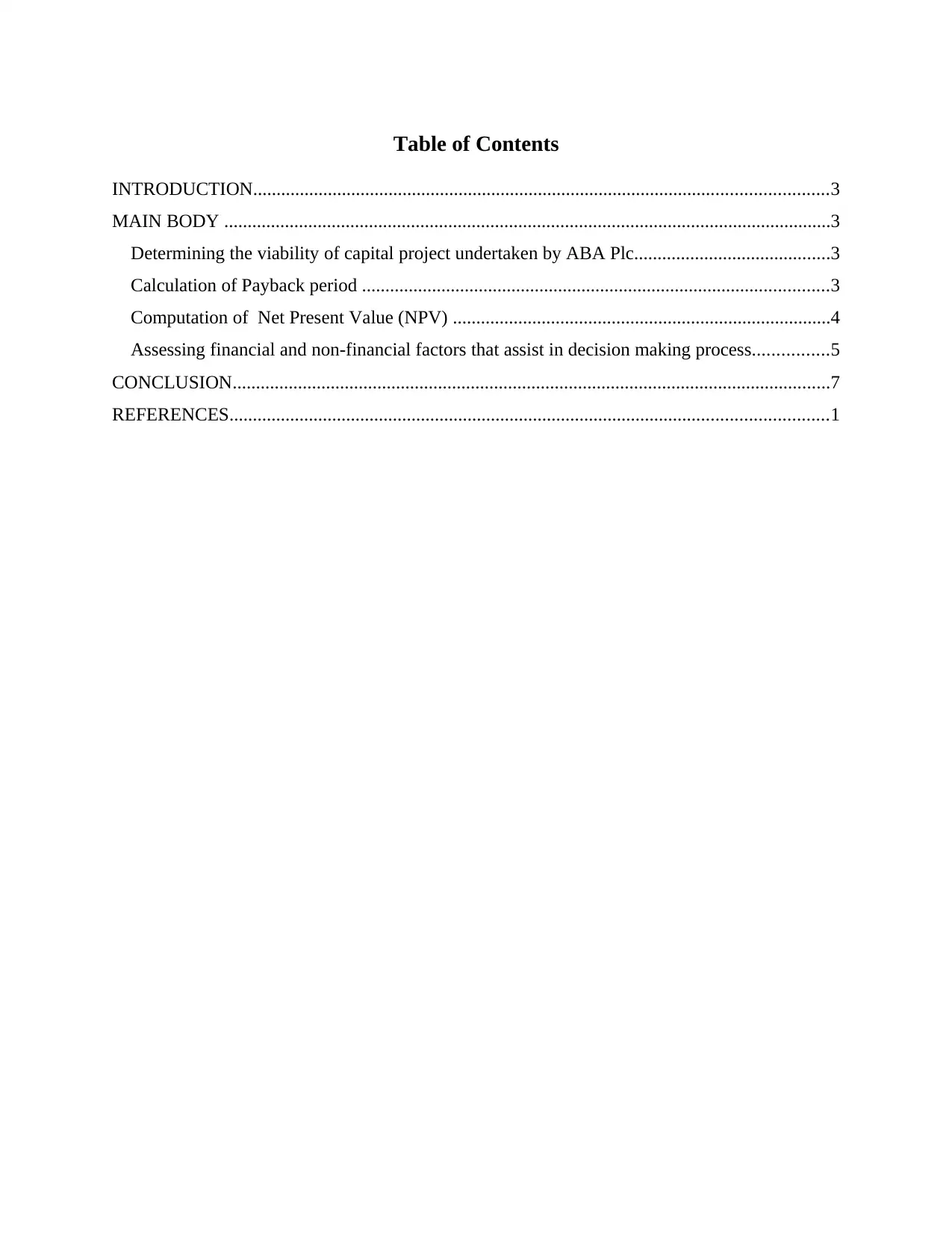
Table of Contents
INTRODUCTION...........................................................................................................................3
MAIN BODY ..................................................................................................................................3
Determining the viability of capital project undertaken by ABA Plc..........................................3
Calculation of Payback period ....................................................................................................3
Computation of Net Present Value (NPV) .................................................................................4
Assessing financial and non-financial factors that assist in decision making process................5
CONCLUSION................................................................................................................................7
REFERENCES................................................................................................................................1
INTRODUCTION...........................................................................................................................3
MAIN BODY ..................................................................................................................................3
Determining the viability of capital project undertaken by ABA Plc..........................................3
Calculation of Payback period ....................................................................................................3
Computation of Net Present Value (NPV) .................................................................................4
Assessing financial and non-financial factors that assist in decision making process................5
CONCLUSION................................................................................................................................7
REFERENCES................................................................................................................................1
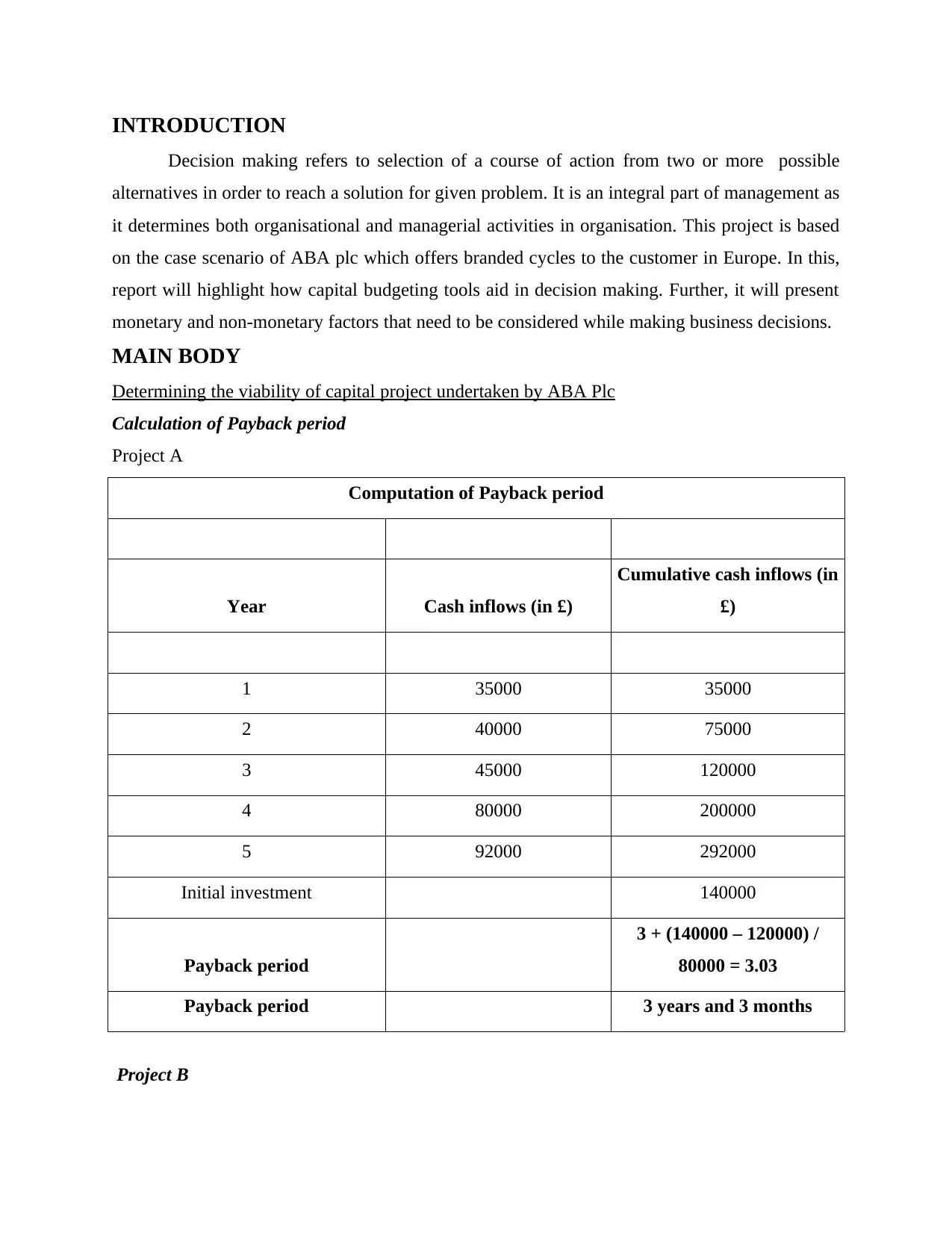
INTRODUCTION
Decision making refers to selection of a course of action from two or more possible
alternatives in order to reach a solution for given problem. It is an integral part of management as
it determines both organisational and managerial activities in organisation. This project is based
on the case scenario of ABA plc which offers branded cycles to the customer in Europe. In this,
report will highlight how capital budgeting tools aid in decision making. Further, it will present
monetary and non-monetary factors that need to be considered while making business decisions.
MAIN BODY
Determining the viability of capital project undertaken by ABA Plc
Calculation of Payback period
Project A
Computation of Payback period
Year Cash inflows (in £)
Cumulative cash inflows (in
£)
1 35000 35000
2 40000 75000
3 45000 120000
4 80000 200000
5 92000 292000
Initial investment 140000
Payback period
3 + (140000 – 120000) /
80000 = 3.03
Payback period 3 years and 3 months
Project B
Decision making refers to selection of a course of action from two or more possible
alternatives in order to reach a solution for given problem. It is an integral part of management as
it determines both organisational and managerial activities in organisation. This project is based
on the case scenario of ABA plc which offers branded cycles to the customer in Europe. In this,
report will highlight how capital budgeting tools aid in decision making. Further, it will present
monetary and non-monetary factors that need to be considered while making business decisions.
MAIN BODY
Determining the viability of capital project undertaken by ABA Plc
Calculation of Payback period
Project A
Computation of Payback period
Year Cash inflows (in £)
Cumulative cash inflows (in
£)
1 35000 35000
2 40000 75000
3 45000 120000
4 80000 200000
5 92000 292000
Initial investment 140000
Payback period
3 + (140000 – 120000) /
80000 = 3.03
Payback period 3 years and 3 months
Project B
⊘ This is a preview!⊘
Do you want full access?
Subscribe today to unlock all pages.

Trusted by 1+ million students worldwide
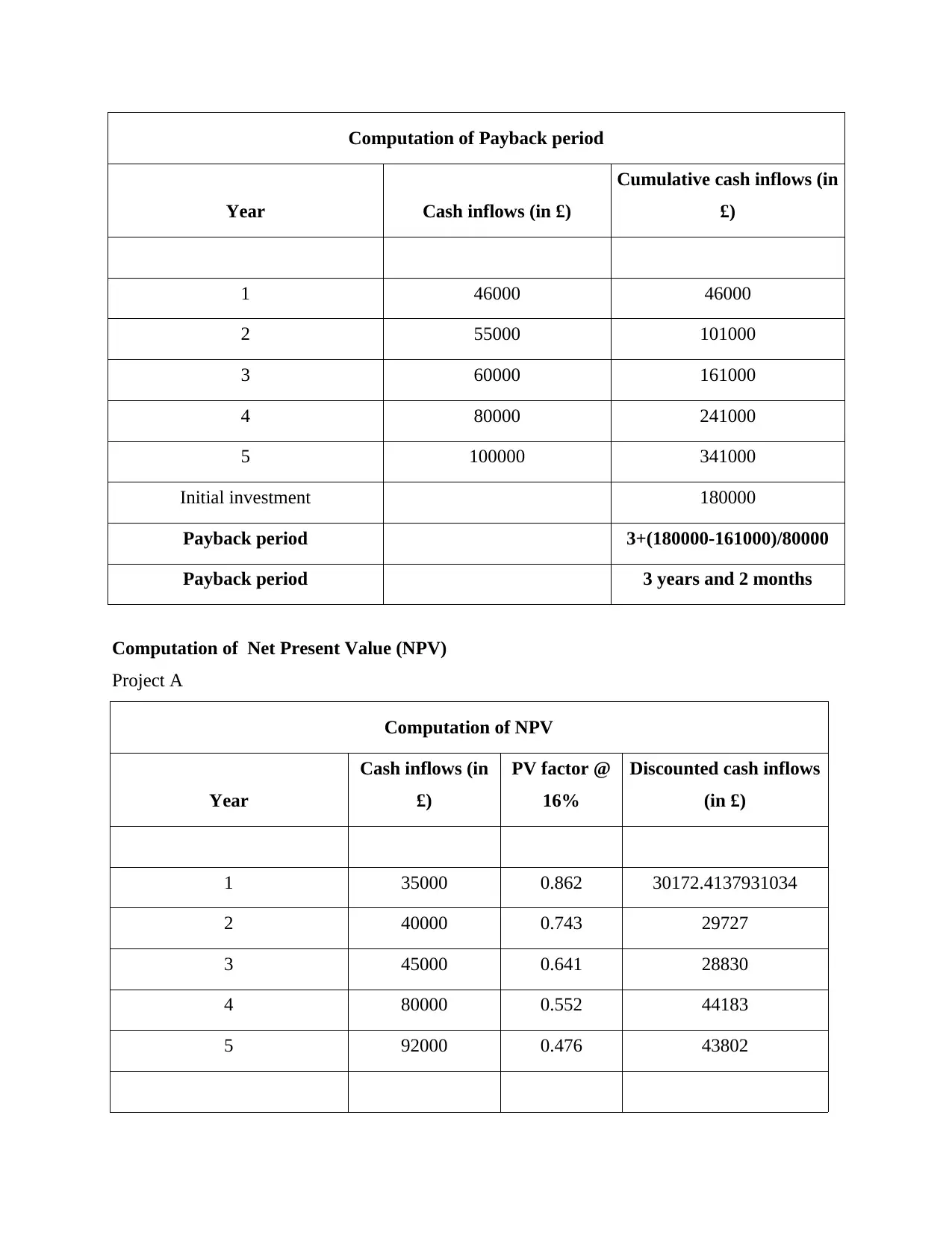
Computation of Payback period
Year Cash inflows (in £)
Cumulative cash inflows (in
£)
1 46000 46000
2 55000 101000
3 60000 161000
4 80000 241000
5 100000 341000
Initial investment 180000
Payback period 3+(180000-161000)/80000
Payback period 3 years and 2 months
Computation of Net Present Value (NPV)
Project A
Computation of NPV
Year
Cash inflows (in
£)
PV factor @
16%
Discounted cash inflows
(in £)
1 35000 0.862 30172.4137931034
2 40000 0.743 29727
3 45000 0.641 28830
4 80000 0.552 44183
5 92000 0.476 43802
Year Cash inflows (in £)
Cumulative cash inflows (in
£)
1 46000 46000
2 55000 101000
3 60000 161000
4 80000 241000
5 100000 341000
Initial investment 180000
Payback period 3+(180000-161000)/80000
Payback period 3 years and 2 months
Computation of Net Present Value (NPV)
Project A
Computation of NPV
Year
Cash inflows (in
£)
PV factor @
16%
Discounted cash inflows
(in £)
1 35000 0.862 30172.4137931034
2 40000 0.743 29727
3 45000 0.641 28830
4 80000 0.552 44183
5 92000 0.476 43802
Paraphrase This Document
Need a fresh take? Get an instant paraphrase of this document with our AI Paraphraser
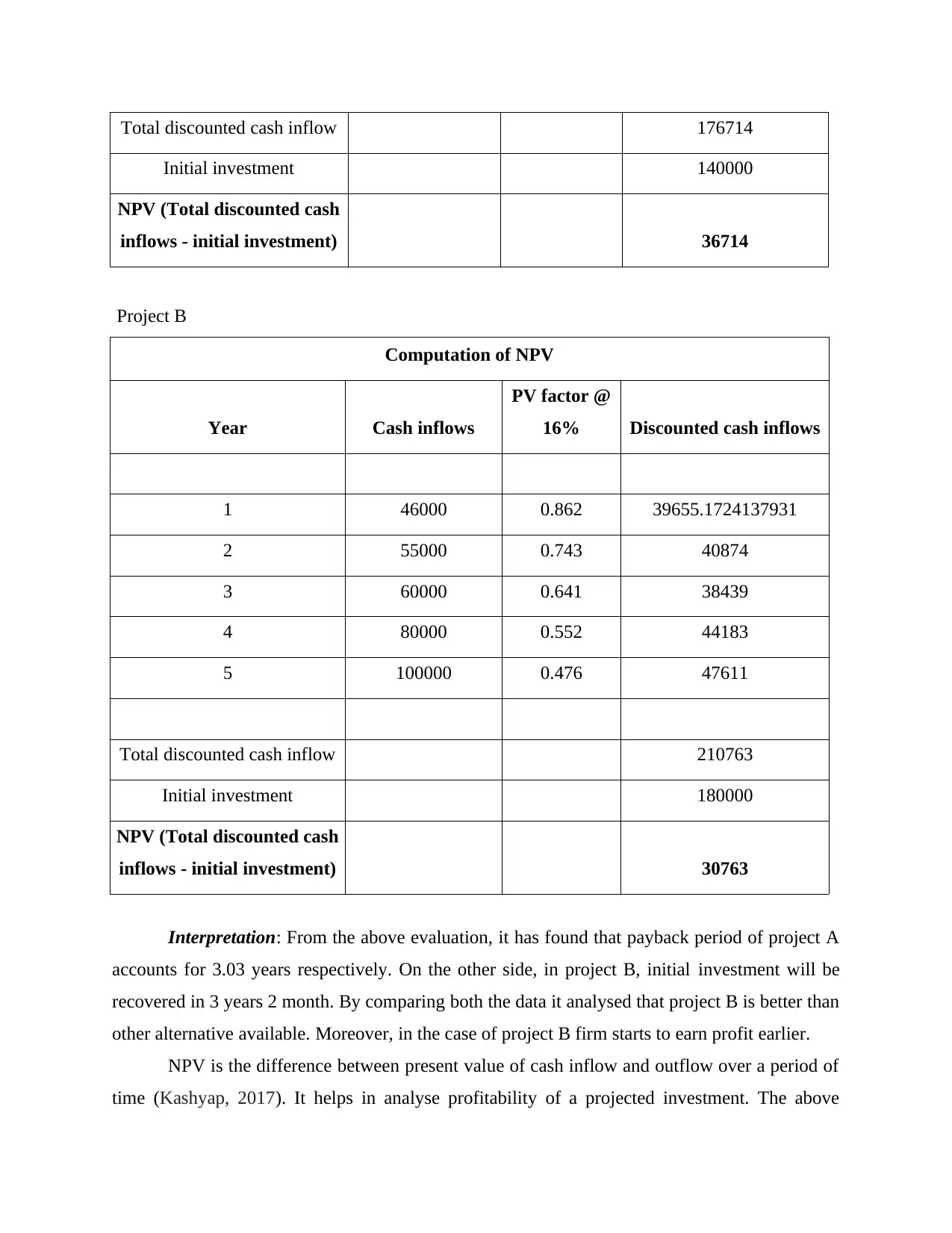
Total discounted cash inflow 176714
Initial investment 140000
NPV (Total discounted cash
inflows - initial investment) 36714
Project B
Computation of NPV
Year Cash inflows
PV factor @
16% Discounted cash inflows
1 46000 0.862 39655.1724137931
2 55000 0.743 40874
3 60000 0.641 38439
4 80000 0.552 44183
5 100000 0.476 47611
Total discounted cash inflow 210763
Initial investment 180000
NPV (Total discounted cash
inflows - initial investment) 30763
Interpretation: From the above evaluation, it has found that payback period of project A
accounts for 3.03 years respectively. On the other side, in project B, initial investment will be
recovered in 3 years 2 month. By comparing both the data it analysed that project B is better than
other alternative available. Moreover, in the case of project B firm starts to earn profit earlier.
NPV is the difference between present value of cash inflow and outflow over a period of
time (Kashyap, 2017). It helps in analyse profitability of a projected investment. The above
Initial investment 140000
NPV (Total discounted cash
inflows - initial investment) 36714
Project B
Computation of NPV
Year Cash inflows
PV factor @
16% Discounted cash inflows
1 46000 0.862 39655.1724137931
2 55000 0.743 40874
3 60000 0.641 38439
4 80000 0.552 44183
5 100000 0.476 47611
Total discounted cash inflow 210763
Initial investment 180000
NPV (Total discounted cash
inflows - initial investment) 30763
Interpretation: From the above evaluation, it has found that payback period of project A
accounts for 3.03 years respectively. On the other side, in project B, initial investment will be
recovered in 3 years 2 month. By comparing both the data it analysed that project B is better than
other alternative available. Moreover, in the case of project B firm starts to earn profit earlier.
NPV is the difference between present value of cash inflow and outflow over a period of
time (Kashyap, 2017). It helps in analyse profitability of a projected investment. The above
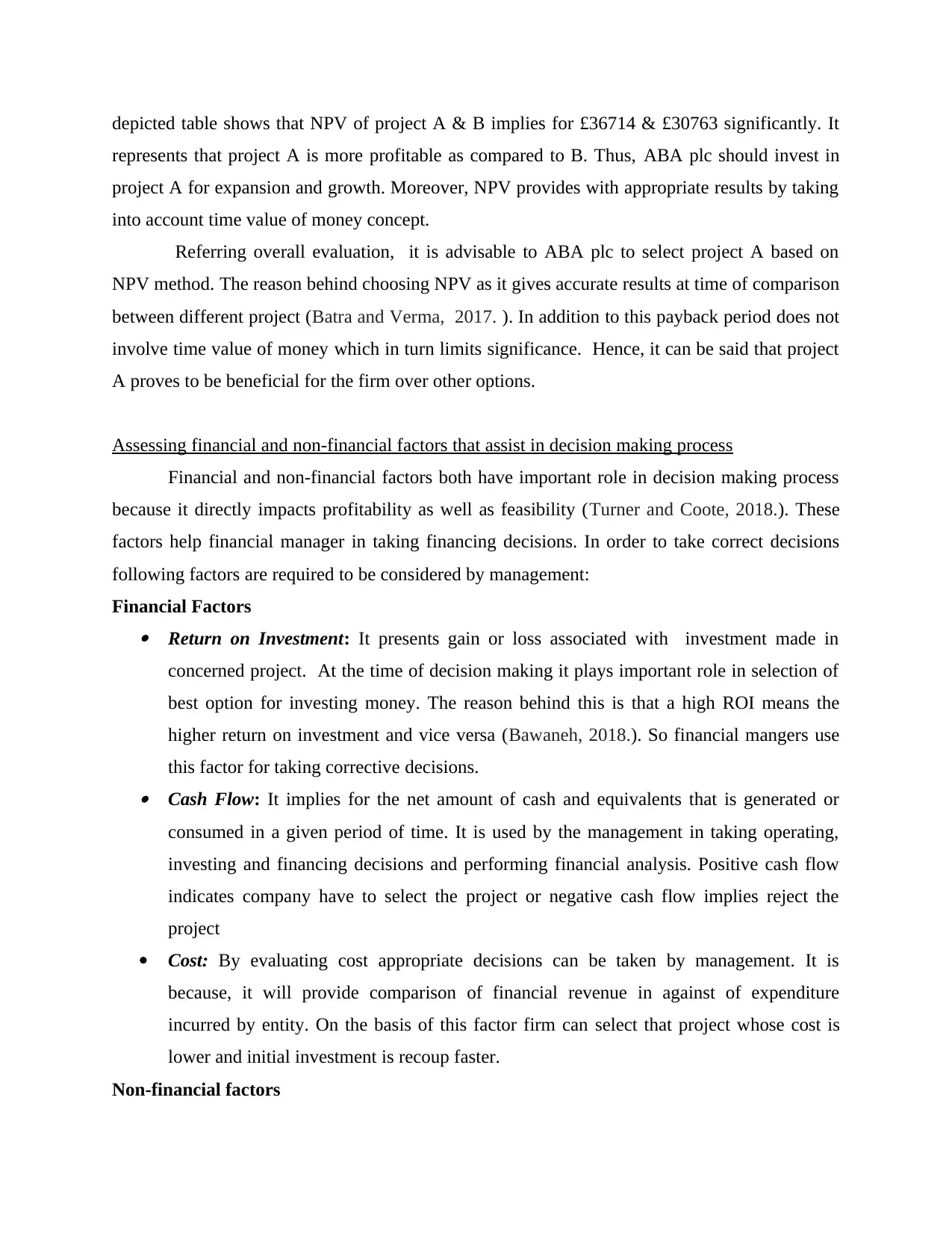
depicted table shows that NPV of project A & B implies for £36714 & £30763 significantly. It
represents that project A is more profitable as compared to B. Thus, ABA plc should invest in
project A for expansion and growth. Moreover, NPV provides with appropriate results by taking
into account time value of money concept.
Referring overall evaluation, it is advisable to ABA plc to select project A based on
NPV method. The reason behind choosing NPV as it gives accurate results at time of comparison
between different project (Batra and Verma, 2017. ). In addition to this payback period does not
involve time value of money which in turn limits significance. Hence, it can be said that project
A proves to be beneficial for the firm over other options.
Assessing financial and non-financial factors that assist in decision making process
Financial and non-financial factors both have important role in decision making process
because it directly impacts profitability as well as feasibility (Turner and Coote, 2018.). These
factors help financial manager in taking financing decisions. In order to take correct decisions
following factors are required to be considered by management:
Financial Factors Return on Investment: It presents gain or loss associated with investment made in
concerned project. At the time of decision making it plays important role in selection of
best option for investing money. The reason behind this is that a high ROI means the
higher return on investment and vice versa (Bawaneh, 2018.). So financial mangers use
this factor for taking corrective decisions. Cash Flow: It implies for the net amount of cash and equivalents that is generated or
consumed in a given period of time. It is used by the management in taking operating,
investing and financing decisions and performing financial analysis. Positive cash flow
indicates company have to select the project or negative cash flow implies reject the
project
Cost: By evaluating cost appropriate decisions can be taken by management. It is
because, it will provide comparison of financial revenue in against of expenditure
incurred by entity. On the basis of this factor firm can select that project whose cost is
lower and initial investment is recoup faster.
Non-financial factors
represents that project A is more profitable as compared to B. Thus, ABA plc should invest in
project A for expansion and growth. Moreover, NPV provides with appropriate results by taking
into account time value of money concept.
Referring overall evaluation, it is advisable to ABA plc to select project A based on
NPV method. The reason behind choosing NPV as it gives accurate results at time of comparison
between different project (Batra and Verma, 2017. ). In addition to this payback period does not
involve time value of money which in turn limits significance. Hence, it can be said that project
A proves to be beneficial for the firm over other options.
Assessing financial and non-financial factors that assist in decision making process
Financial and non-financial factors both have important role in decision making process
because it directly impacts profitability as well as feasibility (Turner and Coote, 2018.). These
factors help financial manager in taking financing decisions. In order to take correct decisions
following factors are required to be considered by management:
Financial Factors Return on Investment: It presents gain or loss associated with investment made in
concerned project. At the time of decision making it plays important role in selection of
best option for investing money. The reason behind this is that a high ROI means the
higher return on investment and vice versa (Bawaneh, 2018.). So financial mangers use
this factor for taking corrective decisions. Cash Flow: It implies for the net amount of cash and equivalents that is generated or
consumed in a given period of time. It is used by the management in taking operating,
investing and financing decisions and performing financial analysis. Positive cash flow
indicates company have to select the project or negative cash flow implies reject the
project
Cost: By evaluating cost appropriate decisions can be taken by management. It is
because, it will provide comparison of financial revenue in against of expenditure
incurred by entity. On the basis of this factor firm can select that project whose cost is
lower and initial investment is recoup faster.
Non-financial factors
⊘ This is a preview!⊘
Do you want full access?
Subscribe today to unlock all pages.

Trusted by 1+ million students worldwide
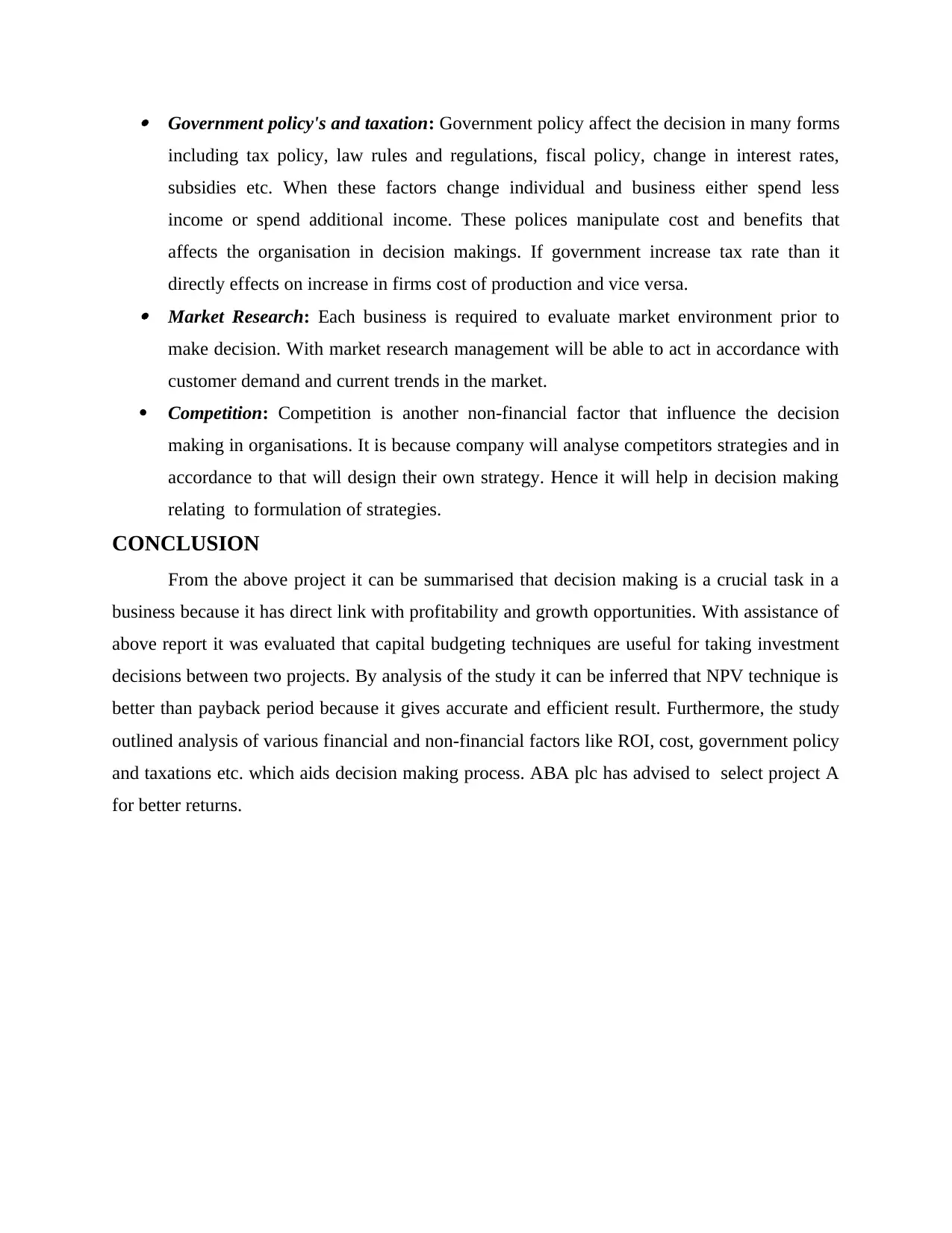
Government policy's and taxation: Government policy affect the decision in many forms
including tax policy, law rules and regulations, fiscal policy, change in interest rates,
subsidies etc. When these factors change individual and business either spend less
income or spend additional income. These polices manipulate cost and benefits that
affects the organisation in decision makings. If government increase tax rate than it
directly effects on increase in firms cost of production and vice versa. Market Research: Each business is required to evaluate market environment prior to
make decision. With market research management will be able to act in accordance with
customer demand and current trends in the market.
Competition: Competition is another non-financial factor that influence the decision
making in organisations. It is because company will analyse competitors strategies and in
accordance to that will design their own strategy. Hence it will help in decision making
relating to formulation of strategies.
CONCLUSION
From the above project it can be summarised that decision making is a crucial task in a
business because it has direct link with profitability and growth opportunities. With assistance of
above report it was evaluated that capital budgeting techniques are useful for taking investment
decisions between two projects. By analysis of the study it can be inferred that NPV technique is
better than payback period because it gives accurate and efficient result. Furthermore, the study
outlined analysis of various financial and non-financial factors like ROI, cost, government policy
and taxations etc. which aids decision making process. ABA plc has advised to select project A
for better returns.
including tax policy, law rules and regulations, fiscal policy, change in interest rates,
subsidies etc. When these factors change individual and business either spend less
income or spend additional income. These polices manipulate cost and benefits that
affects the organisation in decision makings. If government increase tax rate than it
directly effects on increase in firms cost of production and vice versa. Market Research: Each business is required to evaluate market environment prior to
make decision. With market research management will be able to act in accordance with
customer demand and current trends in the market.
Competition: Competition is another non-financial factor that influence the decision
making in organisations. It is because company will analyse competitors strategies and in
accordance to that will design their own strategy. Hence it will help in decision making
relating to formulation of strategies.
CONCLUSION
From the above project it can be summarised that decision making is a crucial task in a
business because it has direct link with profitability and growth opportunities. With assistance of
above report it was evaluated that capital budgeting techniques are useful for taking investment
decisions between two projects. By analysis of the study it can be inferred that NPV technique is
better than payback period because it gives accurate and efficient result. Furthermore, the study
outlined analysis of various financial and non-financial factors like ROI, cost, government policy
and taxations etc. which aids decision making process. ABA plc has advised to select project A
for better returns.
Paraphrase This Document
Need a fresh take? Get an instant paraphrase of this document with our AI Paraphraser
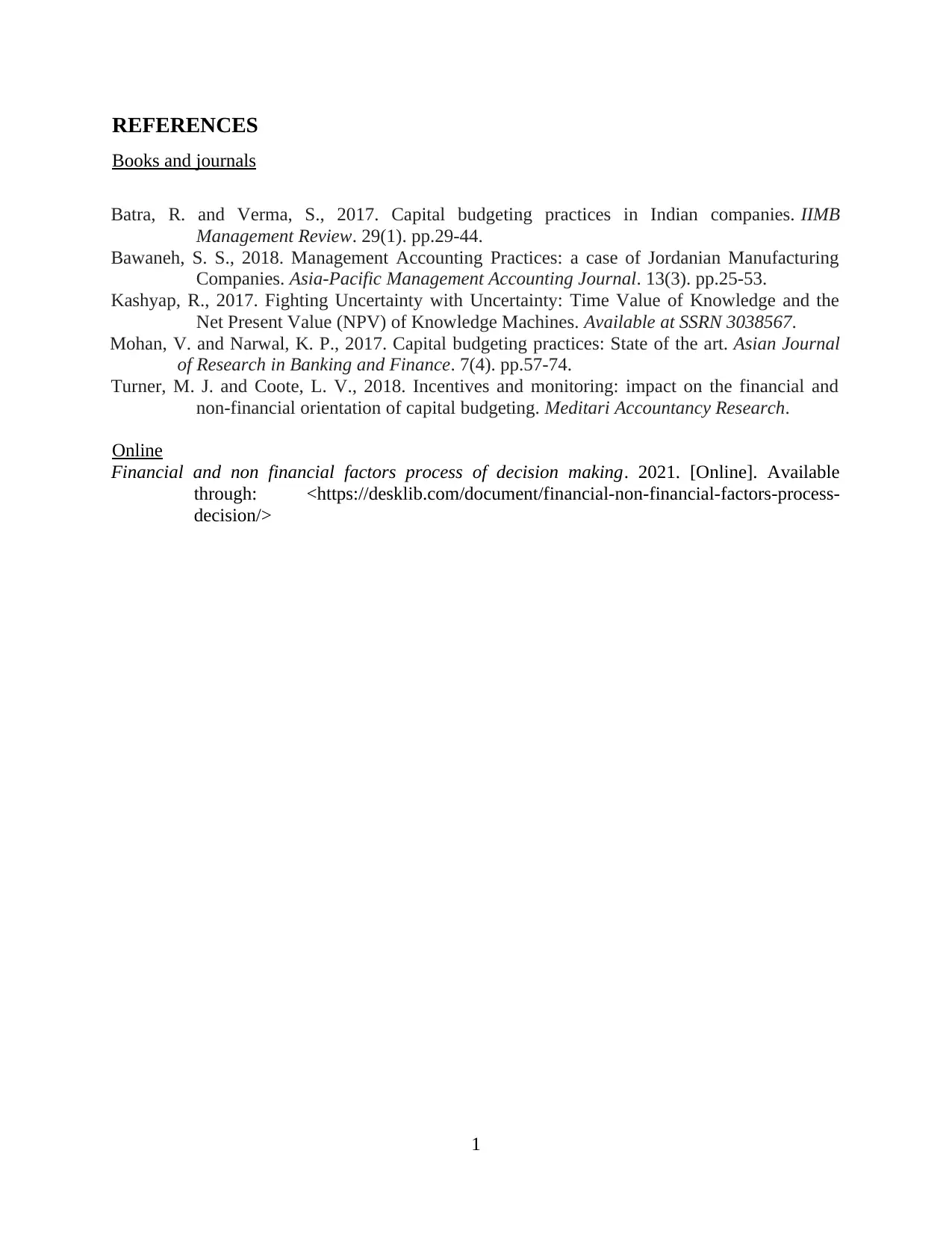
REFERENCES
Books and journals
Batra, R. and Verma, S., 2017. Capital budgeting practices in Indian companies. IIMB
Management Review. 29(1). pp.29-44.
Bawaneh, S. S., 2018. Management Accounting Practices: a case of Jordanian Manufacturing
Companies. Asia-Pacific Management Accounting Journal. 13(3). pp.25-53.
Kashyap, R., 2017. Fighting Uncertainty with Uncertainty: Time Value of Knowledge and the
Net Present Value (NPV) of Knowledge Machines. Available at SSRN 3038567.
Mohan, V. and Narwal, K. P., 2017. Capital budgeting practices: State of the art. Asian Journal
of Research in Banking and Finance. 7(4). pp.57-74.
Turner, M. J. and Coote, L. V., 2018. Incentives and monitoring: impact on the financial and
non-financial orientation of capital budgeting. Meditari Accountancy Research.
Online
Financial and non financial factors process of decision making. 2021. [Online]. Available
through: <https://desklib.com/document/financial-non-financial-factors-process-
decision/>
1
Books and journals
Batra, R. and Verma, S., 2017. Capital budgeting practices in Indian companies. IIMB
Management Review. 29(1). pp.29-44.
Bawaneh, S. S., 2018. Management Accounting Practices: a case of Jordanian Manufacturing
Companies. Asia-Pacific Management Accounting Journal. 13(3). pp.25-53.
Kashyap, R., 2017. Fighting Uncertainty with Uncertainty: Time Value of Knowledge and the
Net Present Value (NPV) of Knowledge Machines. Available at SSRN 3038567.
Mohan, V. and Narwal, K. P., 2017. Capital budgeting practices: State of the art. Asian Journal
of Research in Banking and Finance. 7(4). pp.57-74.
Turner, M. J. and Coote, L. V., 2018. Incentives and monitoring: impact on the financial and
non-financial orientation of capital budgeting. Meditari Accountancy Research.
Online
Financial and non financial factors process of decision making. 2021. [Online]. Available
through: <https://desklib.com/document/financial-non-financial-factors-process-
decision/>
1
1 out of 8
Related Documents
Your All-in-One AI-Powered Toolkit for Academic Success.
+13062052269
info@desklib.com
Available 24*7 on WhatsApp / Email
![[object Object]](/_next/static/media/star-bottom.7253800d.svg)
Unlock your academic potential
Copyright © 2020–2025 A2Z Services. All Rights Reserved. Developed and managed by ZUCOL.





